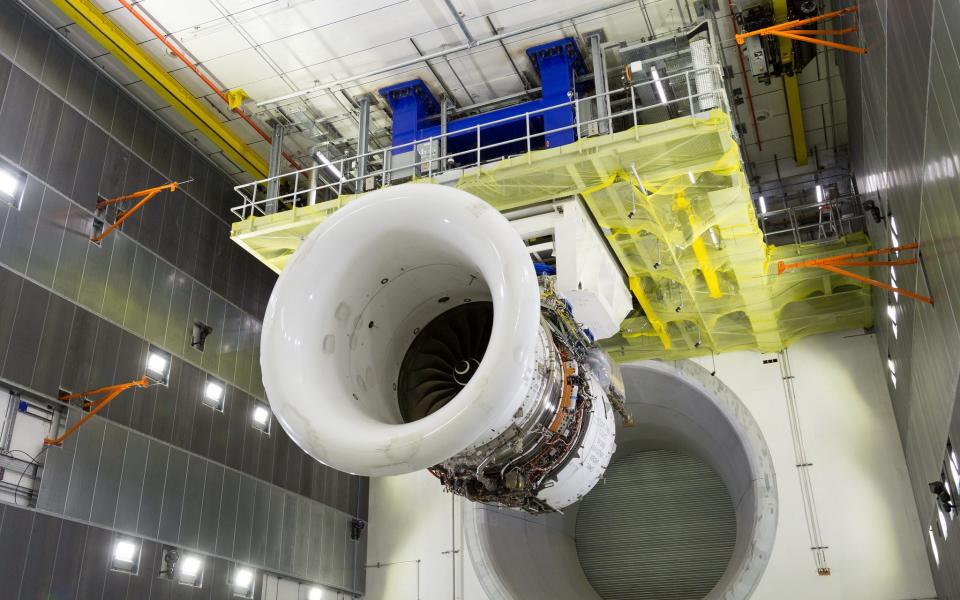Rolls-Royce unveils giant jet engine testbed in Derby

Rolls-Royce has opened the world’s largest indoor jet engine test bed, a £90m bet on the company’s future despite the current crash in air travel.
Bigger than a football pitch, the facility in the company’s home town of Derby took three years to build and is capable of running the very largest gas turbines Rolls produces - along with future even bigger jets - at full power.
It is big enough to hold the company’s newest Ultrafan engine, which at 11.7 feet (3.6m) across is wider than the fuselage of Concorde.
The massive building is kitted out with advanced monitoring equipment that allows engineers to observe 10,000 parameters at a rate of 200,000 samples per second, with data able to be sent instantly to Rolls facilities around the world.
Engines can also be X-rayed while running, allowing designers to see inside them as they burn fuel at 1,000 degrees, sucking in the equivalent of an Olympic-sized swimming pool full of air every second.
Warren East, chief executive, said: “Testbed 80 is not only big, it is also smart and has the most advanced testing technology we have ever used.
“This incredible piece of infrastructure is a very visible sign of our commitment to this site and secures the future of Derby as the home of large engine development.”
The investment comes despite Rolls taking a battering from the collapse in global air travel caused by the pandemic.
He added that the facility would be “critical” in the development of the Ultrafan, which will use 25pc less fuel than Rolls’s first jet engines.

Mr East said that cutting fuel consumption is an essential component in the drive towards reducing emissions from the air travel sector, as modern engines are expected to run on sustainable aviation fuel (SAF) which he conceded “are going to be initially at least rather more expensive than their fossil equivalent.”
Testbed 80 will also be used to developed future generations of aircraft engines which are likely to utilise electric power.
The facility was opened by Business Secretary Kwasi Kwarteng, who called it a “huge rejection of the spirit of pessimism and a huge vote of confidence in Derby and Britain as places to do business.”
He added: “This is a commitment that shows that Britain is a world-leading hub of innovation and progress in the aerospace industry.
“It also dovetails very nicely with net zero and our international leadership in climate change.”
Rolls revealed last year it was cutting about 15pc of its workforce, some 9,000 jobs, with a third of the redundancies coming in the UK as it restructured in response to the pandemic.
The company’s annual results in March showed pre-tax losses of £2.9bn, triple the previous year's level. Revenues fell by almost 30pc to £11.8bn.
On an underlying basis the pre-tax loss was worse at £4bn, higher than the £3.1bn analysts had expected, and down from 2019's profit of £583m.
Mr East said the £9bn of liquidity Rolls has after raising £7.3bn of new debt and equity would be "ample to last us through to 2022 even if there is no improvement whatsoever this year or next".
Other countries including France, Germany and the US have had billions of direct government support pumped into their aerospace industries to prop them up.
This has not been the case in Britain, which until recently had the world’s second largest aerospace sector after the US. Britain has since dropped to third place after France and is on the verge of being overtaken by Germany
Mr Kwarteng said he was seeking more support for the UK’s Aerospace Technology Institute, which had £1.9bn of government support between 2013 and 2016.
The Business Secretary said: “Going into the spending review, I will be asking to really protect the ATI and to enhance it. The Chancellor and I are fully conscious of the aviation sector being a key British success story - and we want to get back to second place."

 Yahoo Finance
Yahoo Finance 